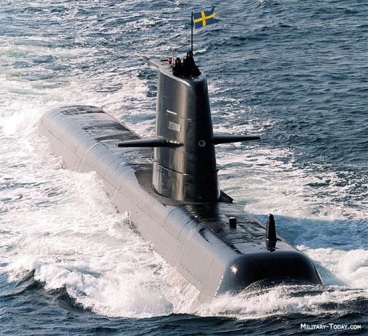Götland-class
Summary
| Origin country | 🇸🇪 Sweden |
| Category | Submarine |
| Subtype | Attack submarine |
| Manufacturer | Kockums |
| Year commissioned | 1996 |
| Units | GOTLAND, UPPLAND, HALLAND |
| Current operators | 🇸🇪 Sweden |
Description
The Gotland-class submarines are a fleet of modern diesel-electric attack submarines in service with the Swedish Navy, crafted by the Kockums shipyard in Sweden. Pioneering in their kind, these submarines stand out due to their integration of the Stirling engine air-independent propulsion (AIP) system, which notably extends their capability to remain submerged—previously a feature characteristic of nuclear-powered submarines—from days to weeks.
Designed for multifaceted naval roles, the Gotland-class
submarines are intended for anti-ship/anti-submarine warfare, intelligence collection, surveillance, special operations, and mine-laying. Their operational efficiency is largely fueled by dual MTU engines on the surface and a Kockums-built Stirling engine AIP system when submerged. This Stirling engine, notable for its quiet operation and effective use of seawater as a cooling medium, powers a generator used for propulsion or charging batteries. The liquid oxygen-dependent endurance of these crafts is euphemistically described as "weeks." Featuring a robust combat system, these submarines boast a low acoustic signature and substantial shock resistance, while their design—centered around stealth and maneuverability—includes an X rudder configuration for agility and ship automation for streamlined operation.
Stealth capabilities are paramount in the Gotland class, rendered through vibration-damping mounting of machinery, hydrodynamic hull design, and electromagnetic countermeasures to minimize the boat's magnetic signature. The hull and masts are treated with coatings to thwart active sonar detection, and their radar-absorbent material further fortifies concealment efforts. These submarines can operate with near-silence, primarily within the Baltic Sea, heavily favoring stealth engagements.
In the realm of operational history, the Gotland class has demonstrated its prowess through various deployments, including refit Gotland-class submarine HSwMS Halland’s successful exercises in the Mediterranean and the Atlantic in 2000. Here, the submarine impressively evaded detection while managing to "defeat" naval units from Spain, France, and the USS Houston during mock battles.
The uniqueness of the Gotland-class submarines attracted international interest, leading to HSwMS Gotland being leased to the United States Navy for antisubmarine warfare exercises. This lease, which initially spanned one year from 2005, was extended due to the productive and revelatory nature of the exercises—including a notable instance where HSwMS Gotland captured images of the USS Ronald Reagan, exemplifying its capability to "sink" an aircraft carrier during exercises.
To preserve the operational longevity of these vessels, the Swedish Defence Material Administration (FMV) and Saab Kockums signed a contract in 2015 for mid-life upgrades. These upgrades, intended to maintain active service capability beyond 2025, encompass overhauls for HSwMS Gotland and HSwMS Uppland. The Gotland resurfaced in action in June 2018 after receiving extensive system modifications, with similar updates also slated for future A26 submarines. HSwMS Uppland followed suit with a relaunch in June 2019 and subsequently rejoined the fleet in December 2020. An additional contract in March 2022 ensures the renovation of HMS Halland.
Technical specifications
| Götland | |
|---|---|
| Displacement | 1494 tons |
| Displacement submerged | 1600 tons |
| Crew | 32 members |
| Width | 6.2 m (20.3 ft) |
| Length | 60.4 m (198.2 ft) |
| Max. depth | 300 m (984.3 ft) |
| Propulsion | 2 MTU diesels with a power of 2,040 hp total - 1 propeller |
| Armament | 4 533mm TLTs (12 torpedoes) + 2 400mm TLTs (4 torpedoes) |
| Maximum speed | 11 knots |
| Max. speed submerged | 20 knots |
Photo of Götland class

Silhouette
